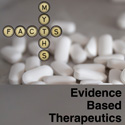In our 21st episode we jump into our ongoing debate about low and very low dose of medication. We present the reason why initial doses of new drugs are often too high and the logic for trialing lower doses in patients. We also review over 10 examples of medications proven in randomized control trials to be equally effective (or more) at lower doses. Although promoting low dose, the size of the podcast is moderate dose (while the quality is high dose with minimal side-effects).
Show Notes
1) Examples of evidence for effective lower doses – these examples typically show lower doses were as effective as higher doses, but in some of the examples higher doses were somewhat more effective but lower doses nonetheless produced clinically important results
6.25 mg of hydrochlorothiazide is effective at lowering blood pressure, and comes in a number of combination products – initially 50 to 200 mg was the recommended starting dose
Arch Int Med 1994;154:1461-8
6.25 mg of captopril has been shown to be effective for blood pressure yet captopril 25 mg PO TID is still a commonly recommended initial starting dose for hypertension.
Circulation 1983;67:1340-6
25 mg of sildenafil (Viagra) has been shown to be an effective dose for erectile dysfunction
Bandolier
25 mg of sumatriptan (Imitrex) works almost as well as100 mg and in fact for most drugs in this class there is a flat dose-response curve seen at the doses studied.
Cephalalgia 2002;22:633-58.
5 mg daily of fluoxetine (Prozac) has been shown to have an effect similar to 20 mg daily.
N Engl J Med 1994;331:1354-61
0.25 mg (1/40th of the recommended initial starting dose of 10 mg) of ezetimibe (Ezetrol) provides 50% of the LDL lowering effect seen with 10 mg
Clin Ther 2001;23:1209-30
15 mg of elemental iron daily has been shown to be as effective for anemia as 50 mg and 150 mg, with a lower incidence of side effects.
Am J Med 2005;118:1142-7
150 mg daily of bupropion (Zyban) produces the same rate of smoking cessation at one year as 300 mg daily.
N Engl J Med 1997;337:1195-202
200 mg of ibuprofen (Motrin) is as effective as 400 mg for migraine headache.
Headache 2001;41:665-79
25 mg of ranitidine (Zantac) has been shown to be as effective as 125 mg for heartburn relief.
Aliment Pharmacol Ther 1999;13:475-81
Compared to standard-dose treatment, low-doses of depot antipsychotics improve psychosocial function and reduce the frequency of side effects.
Schizophrenia bulletin 1993;19:155-64
Tricyclic antidepressant doses of 75-100mg are as effective for depression as doses greater than100mg.
BMJ 2002;325:991-5
500 and 1000 µg of oral B12 was more effective than 2.5, 100 or 250 µg at improving the surrogate marker of B12 deficiency (methylmalonic acid).
Arch Intern Med. 2005;165:1167-1172
Meta-analysis showing higher doses of statins produced greater reductions in cardiovascular events – as an aside, a number of these trials compared different drugs in addition to different doses and the difference in outcome was approximately 1.5% in cardiovascular outcomes
CMAJ 2008;178:576-84
2) Doubling the dose of inhaled corticosteroids for asthma exacerbations is not effective
Lancet 2004;363:271-5
Thorax 2004;59:550–6


